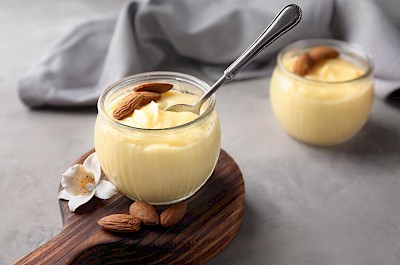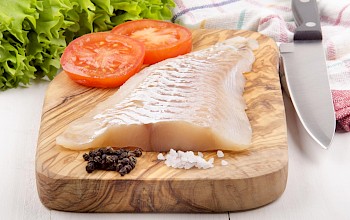Pudding: Calories and Nutrition Analyse
How many calories in pudding?

Nutrition Facts
PuddingServing size:
standard serving size (0,5 cup) of pudding (120 g) change
5g10g15g20g30g40g50g60g80g100g120g140g160g180g200g220g250g300g350g400g450g500g600g700g800g900g1000g
1oz2oz3oz4oz5oz6oz7oz8oz10oz12oz15oz20oz25oz30oz35oz40oz50oz
Amount Per Serving:
100g of pudding contain about 142 calories (kcal).
Calories per:
ounce
| standard serving size, cup
| half cup
In particular, a standard serving size (0,5 cup) of pudding (120 g) contain about 170 calories.
This is about 9% of the daily caloric intake for an average adult with medium weight and activity level (assuming a 2000 kcal daily intake).
Scroll down for details and nutrition tables.
To visualize how much 170 kcal actually is, keep in mind that the calorie content of pudding is similar to that of, for example:
- 3 apples
- 2 glasses of Coca Cola (220 ml glass)
- 1.5 slices of cheese
- 1.5 slices of bread
- 1 glass of milk
- 8.5 cubes of sugar
Take a quick look at the tables below for detailed information about pudding nutrition.
100g of Pudding
Nutrition
- Calories142
- Carbs Total23.01 g
- Dietary fiber0 g
- Fat4.6 g
- Protein2.09 g
- Water69.46 g
Vitamins
- Vit B1 (Thiamine)0.024 mg
- Vit B2 (riboflavin)0.072 mg
- Vit B3 (Niacin)0.123 mg
- Vit B60.018 mg
- Vit B9 (Folic acid)0.003 mcg
- Vit C0.3 mg
- Vit E0.31 mg
- Vit K0.001 mg
Minerals
- Potassium184 mg
- Magnessium18 mg
- Calcium51 mg
- Sodium152 mg
- Iron1.27 mg
Delving into the Sweet World of Pudding: A Nutritional Perspective
When we think of pudding, we often envision a creamy, comforting dessert that brings back childhood memories. However, beyond its delicious taste, pudding holds various nutritional values that can play a part in a balanced diet. Understanding the pudding calories, pudding nutrition, and the balance of protein, fat, and carbs in pudding can help you make informed choices about incorporating this dessert into your meals.
Nutritional Breakdown of Pudding
Pudding can vary widely in its nutritional content based on the ingredients used in its preparation. Here's a general overview of what you might expect from a standard serving of pudding (approximately 100 grams):
- Calories: 142
- Carbohydrates: 23.01g
- Fiber: 0g
- Fat: 4.6g
- Protein: 2.09g
- Sugar: 17.17g
- Water: 69.46%
- Calcium: 51mg
- Iron: 1.27mg
- Magnesium: 18mg
- Cholesterol: 1mg
- Potassium: 184mg
- Sodium: 152mg
These values can help us understand the role pudding can play in our diet. For instance, its relatively low protein and high sugar content make it more suitable as an occasional treat rather than a staple food item.
The Role of Pudding in a Healthy Diet
While pudding is often seen as a dessert, its nutritional content allows it to fit into a healthy diet when consumed in moderation. The key is to look at the fat in pudding, especially if it's made with whole milk or cream, and balance it with the rest of your day's dietary intake. Similarly, the carbs in pudding, primarily from sugars, should be considered, especially for those monitoring their sugar intake.
However, pudding can also contribute beneficial nutrients. For example, the calcium and potassium found in pudding can support bone health and regulate blood pressure, respectively. Moreover, the iron content can help in preventing anemia.
Choosing the Right Pudding for Your Diet
When selecting a pudding, consider the following tips to align with your nutritional goals:
- Opt for puddings made with low-fat or almond milk to reduce fat content.
- Look for sugar-free options or puddings sweetened with natural sweeteners to lower sugar intake.
- Choose puddings enriched with vitamins and minerals to enhance their nutritional value.
In conclusion, while pudding is often categorized as a simple dessert, its nutritional profile reveals that it can be part of a balanced diet when chosen wisely and consumed in moderation. By paying attention to the pudding calories, protein, fat, and carbs, you can enjoy this delightful dessert without compromising your health goals.
How many calories are there in 1, 2, 3, or 5 servings of pudding?
- Standard serving size (0,5 cup) of pudding (120 g)170 kcal
- Cup of pudding (240g)341 kcal
- Half cup of pudding (120g)170 kcal
- Ounce (oz) of pudding40 kcal
- Half of medium size servings of pudding85 kcal
- Small size serving of pudding (96g)136 kcal
- Big size pudding (156g)221 kcal
- Two medium size servings of pudding340 kcal
- Three medium size servings of pudding510 kcal
- Four medium size servings of pudding680 kcal
- Five medium size servings of pudding850 kcal

Similar calories number have:
See also:
Read this:
- How many calories does pea salad have?
- Calories in a half of philly cheesesteak
- Calories in whole philly cheesesteak
- Calories for one, two or more philly cheesesteak
- How many carbs (carbohydrates) in ham pot pie?
- How much fat in california sushi roll?
- How much protein in white onion?
- What is weight of donut hole?
- Puerto Rican sandwich calories per ounce (oz)
- Moscow mule calories per serving size



Add comment